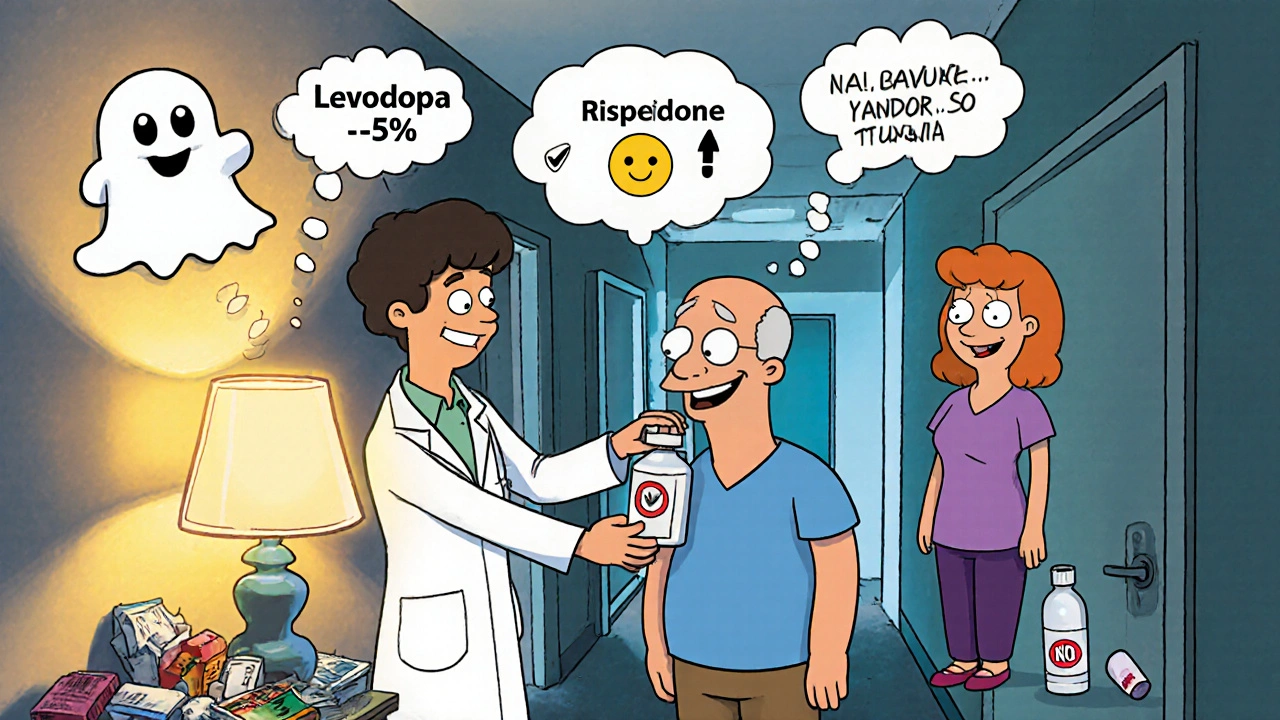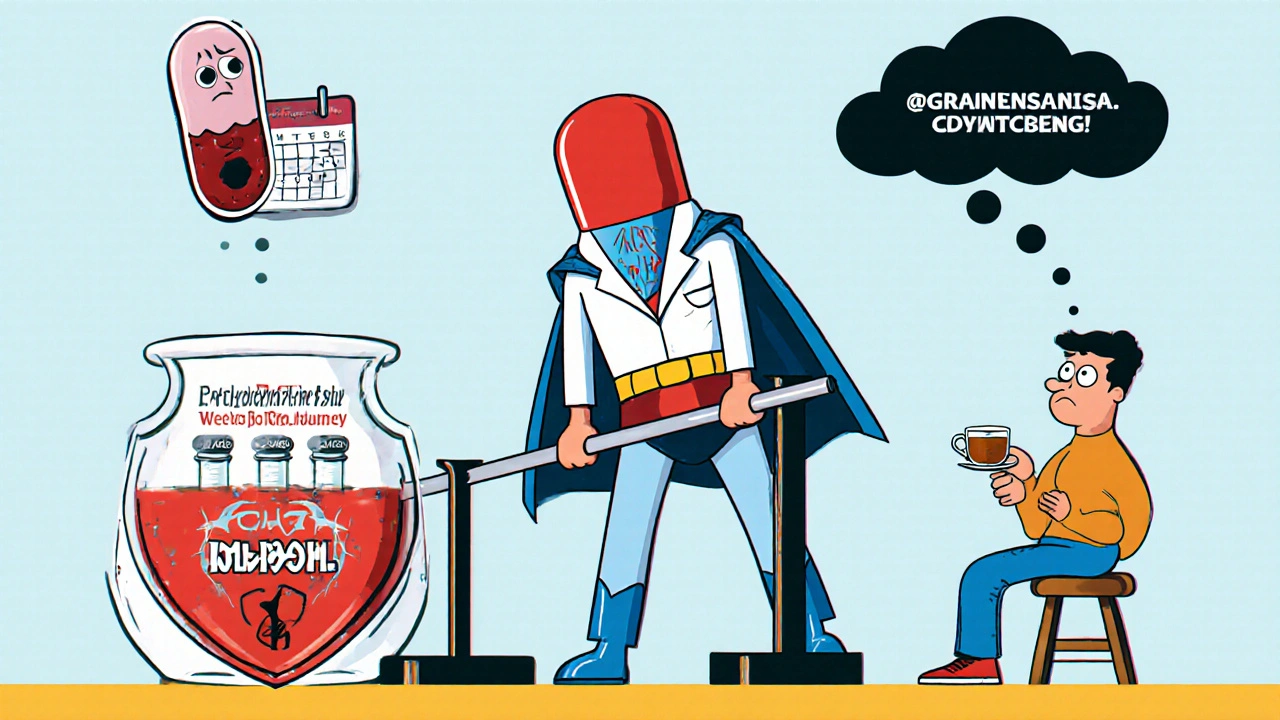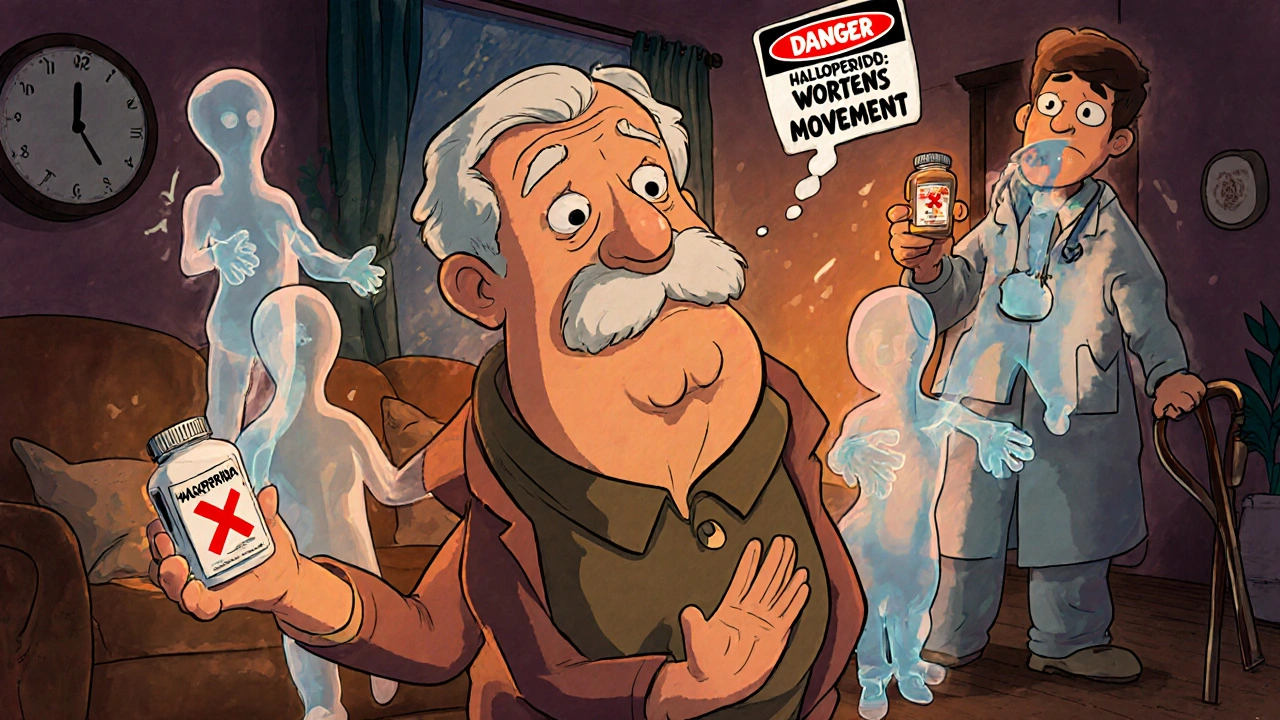Parkinson's Antipsychotic Safety Calculator
Select a medication to see safety details
For someone living with Parkinson’s disease, the tremors, stiffness, and slow movement are already hard enough to manage. But when hallucinations or delusions start creeping in - seeing people who aren’t there, believing things that aren’t true - the pressure to treat psychosis feels urgent. The problem? Many of the drugs doctors reach for to calm those symptoms can make the motor problems much worse.
Why Antipsychotics Are a Double-Edged Sword
Parkinson’s disease is caused by the loss of dopamine-producing neurons in the brain. Dopamine isn’t just about mood - it’s essential for smooth, controlled movement. That’s why levodopa, a dopamine replacement, is the cornerstone of treatment. But psychosis in Parkinson’s - called Parkinson’s disease psychosis (PDP) - affects about one in four patients, according to the Parkinson’s Foundation. When it happens, families and caregivers often push for medication. The catch? Almost all traditional antipsychotics work by blocking dopamine receptors, especially the D2 subtype. That’s great for reducing hallucinations in schizophrenia, but disastrous in Parkinson’s, where dopamine is already in short supply.The Worst Offenders: First-Generation Antipsychotics
First-generation antipsychotics (FGAs) like haloperidol, fluphenazine, and chlorpromazine are the biggest danger. Haloperidol, often called Haldol, blocks up to 90-100% of D2 receptors at standard doses. In Parkinson’s patients, even tiny amounts - as low as 0.25 mg daily - can trigger sudden rigidity, freezing, or loss of balance. Studies show 70-80% of Parkinson’s patients given haloperidol develop severe parkinsonism. The American Academy of Neurology and the Parkinson’s Foundation both say these drugs should never be used in Parkinson’s patients. Yet, they’re still prescribed, sometimes out of habit or lack of awareness.Quetiapine and Clozapine: The Safer Options
Not all antipsychotics are created equal. Two drugs stand out as safer: clozapine and quetiapine. Both are second-generation antipsychotics (SGAs), meaning they bind less tightly to D2 receptors - only 40-60% occupancy - and they also act on serotonin receptors, which helps reduce motor side effects. Clozapine is the gold standard. It’s the only antipsychotic approved by the FDA specifically for Parkinson’s disease psychosis, since 2016. In clinical trials, it reduced hallucinations and delusions without worsening movement symptoms. One major study showed a 49% improvement in psychosis symptoms with clozapine, while motor scores barely budged - just a 1.8-point increase on the UPDRS-III scale. Compare that to risperidone, which improved psychosis by 47% but spiked motor scores by 7.2 points. That’s a massive difference. But clozapine has a serious catch: it can cause agranulocytosis, a dangerous drop in white blood cells. That’s why patients need weekly blood tests for the first six months. If the absolute neutrophil count falls below 1,500 cells/μL, the drug must be stopped. It’s a hassle, but for many, it’s worth it. Quetiapine (Seroquel) is often used off-label because it’s easier to monitor. Doses are low - usually 12.5 to 25 mg at night - and most patients see improvement in psychosis within one to two weeks. But here’s the controversy: some studies, including a 2017 double-blind trial, found quetiapine performed no better than a placebo. Still, many neurologists continue using it because it’s safer than risperidone or olanzapine, and it works for some patients. It’s not perfect, but it’s often the best available option when clozapine isn’t feasible.
The Drugs That Sound Good But Are Dangerous
Olanzapine (Zyprexa) and risperidone (Risperdal) are frequently tried - and frequently fail. A 1999 study of 12 Parkinson’s patients on olanzapine found that while 75% had better psychosis, 75% also had worse movement symptoms. Half of them got so stiff and slow they had to stop the drug. Risperidone is even more troubling. One study showed 100% of Parkinson’s patients had motor worsening. Another 2005 trial confirmed it: risperidone caused nearly four times more motor decline than clozapine. And the risk isn’t just discomfort - a 2013 Canadian study found risperidone nearly doubled the risk of death in Parkinson’s patients.Pimavanserin: A New Hope - With Caveats
In 2022, the FDA approved pimavanserin (Nuplazid) as the first antipsychotic that doesn’t block dopamine at all. It works by targeting serotonin 5-HT2A receptors, which are overactive in Parkinson’s psychosis. In trials, it improved hallucinations without worsening motor symptoms. That’s huge. But there’s a dark side: post-marketing data showed a 1.7-fold increase in death risk. The FDA added a black box warning. It’s not a first-line choice, but for patients who can’t tolerate clozapine or quetiapine, it’s an option - just one that requires careful weighing of risks.
What Comes Before Antipsychotics?
The best strategy isn’t to reach for a pill right away. The Parkinson’s Foundation recommends a three-step approach:- Review all current medications. Sometimes, anticholinergics, dopamine agonists, or even certain antidepressants are triggering psychosis. Reducing or stopping them can make hallucinations disappear.
- Adjust levodopa. Too much can cause hallucinations. Lowering the dose - even by 10-20% - can help without making movement worse.
- Try non-drug approaches. Better lighting, routine, reducing nighttime noise, and caregiver education can cut down on hallucinations.
How to Monitor and When to Stop
If you do start an antipsychotic, monitor closely. The Unified Parkinson’s Disease Rating Scale (UPDRS-III) measures motor function. A 30% increase in score from baseline means the drug is harming movement. That’s the red flag. Doctors should check UPDRS scores every two weeks during the first month. If motor symptoms worsen, stop the drug - don’t wait. Also, don’t rush the dose. Clozapine takes four to six weeks to reach full effect. Quetiapine may work faster, but increasing the dose too quickly can trigger side effects. Start low, go slow.The Bottom Line
Treating psychosis in Parkinson’s isn’t about finding the strongest antipsychotic. It’s about finding the one that does the least harm. Haloperidol and risperidone are dangerous. Olanzapine is risky. Quetiapine is a compromise. Clozapine is the most effective - if you can handle the blood tests. Pimavanserin is promising but carries a death risk. And before any of them? Try adjusting other meds first. For many, that’s enough.There’s no perfect solution. But there is a smart one: prioritize movement. Don’t trade walking for seeing ghosts. The goal isn’t to eliminate all hallucinations - it’s to keep the person safe, stable, and able to move.
Can antipsychotics cause Parkinson’s-like symptoms in people without Parkinson’s?
Yes. Drugs like haloperidol and risperidone can cause drug-induced parkinsonism in anyone, even those without Parkinson’s disease. This includes tremors, stiffness, slow movement, and shuffling gait. It’s called secondary parkinsonism. In most cases, symptoms improve after stopping the drug, but sometimes they linger for months or become permanent. This is why these drugs are avoided in older adults and those with movement disorders.
Is quetiapine safe for elderly Parkinson’s patients?
Quetiapine is generally considered safer than other antipsychotics for elderly Parkinson’s patients, but it’s not risk-free. It can cause drowsiness, low blood pressure, and confusion - all common in older adults. Doses should be kept low (12.5-25 mg at night) and monitored closely. While it doesn’t worsen motor symptoms as much as risperidone, some studies suggest its benefit for psychosis may be minimal. Always weigh sedation and fall risk against hallucination severity.
Why isn’t clozapine used more often if it’s the most effective?
Clozapine requires weekly blood tests for the first six months to check for agranulocytosis, a rare but life-threatening drop in white blood cells. Many primary care doctors and even some neurologists don’t feel comfortable managing this monitoring. Pharmacies also need special certification to dispense it. These logistical hurdles mean clozapine is underused - even though it’s the most effective and safest antipsychotic for Parkinson’s psychosis.
Can non-drug treatments really reduce hallucinations in Parkinson’s?
Yes. Simple changes like improving lighting (especially at night), reducing clutter, maintaining a consistent daily routine, and minimizing sensory overload (like loud TV or radio) can significantly reduce hallucinations. Many patients see fewer episodes when caregivers help them distinguish real from imagined events without arguing. A 2018 study showed 62% of patients improved without any antipsychotic - just by adjusting meds and environment.
What should I do if my loved one with Parkinson’s starts seeing things that aren’t there?
Don’t panic. First, note when it happens - during the day or night? After taking levodopa? Then, schedule a visit with a neurologist who specializes in Parkinson’s. Bring a list of all medications, including over-the-counter ones. Ask: Could any of these be causing this? Could we try lowering levodopa first? Avoid rushing to an antipsychotic. Many cases improve with small tweaks. If medication is needed, insist on clozapine or quetiapine - never haloperidol or risperidone.






robert cardy solano
November 19, 2025 AT 15:57Man, I had no idea haloperidol could wreck Parkinson’s patients like that. My uncle got prescribed it for ‘sleep issues’ and turned into a statue for weeks. Took forever to recover. Doctors really need to stop treating symptoms like they’re in a textbook.
Rebecca Cosenza
November 19, 2025 AT 17:15This is why we need stricter oversight. People are dying because doctors are lazy.
swatantra kumar
November 20, 2025 AT 18:20So let me get this straight - we have a drug (clozapine) that works miracles but requires weekly blood draws, while the dangerous ones (risperidone, haloperidol) are still everywhere? 😅 Sounds like capitalism in a lab coat. At least pimavanserin doesn’t block dopamine… but kills you instead? 🤡
Dave Wooldridge
November 22, 2025 AT 05:24THIS IS A COVER-UP. The pharmaceutical companies know clozapine is the best but they don’t profit from it because of the blood tests. They push risperidone because it’s patent-protected and easy to prescribe. The FDA? They’re in bed with Big Pharma. You think they’d let a cheap, non-patentable drug dominate? HA. Look at the black box warning on pimavanserin - that’s just the *visible* part of the iceberg. They want you dependent on expensive, dangerous drugs. Wake up.
I’ve seen it firsthand. My cousin’s neurologist refused to even mention clozapine until we threatened to sue. Then suddenly - ‘Oh, we can refer you to a specialist!’ Yeah, right. They don’t want to deal with the paperwork. They want the quick cash from a 30-day script. And now? He’s on quetiapine. It barely helps. But at least it doesn’t kill him… yet.
And don’t get me started on ‘non-drug’ solutions. Lighting? Routine? Please. If your loved one is seeing dead relatives, no amount of better lamps is going to fix that. You think the hallucinations are ‘just in their head’? They’re real to them. And if you don’t treat them properly, they’ll spiral into terror, isolation, or worse. But hey, maybe if we just ‘talk to them’ and ‘hold their hand’… oh wait, that’s not profitable.
They’re not treating Parkinson’s psychosis. They’re treating profit margins. And patients? We’re collateral damage in a system designed to keep you sick and buying.
They’ll tell you ‘clozapine is hard to manage.’ Bullshit. It’s not hard - it’s inconvenient. And convenience is what they sell. Not care. Not safety. Not truth.
They’re scared of the blood tests. They’re scared of the liability. They’re scared of the time. But they’re not scared of killing people slowly with risperidone. That’s just ‘standard practice.’
And now we have pimavanserin - the ‘safe’ drug that kills you faster than the others. That’s not innovation. That’s a marketing gimmick with a black box warning shaped like a tombstone.
Someone needs to sue. Someone needs to expose this. Because if your grandma sees her dead husband in the hallway, and the doctor gives her a pill that makes her unable to walk - who’s really responsible?
Not the patient. Not the family. The system.
Pawan Jamwal
November 23, 2025 AT 15:18India has better alternatives than these Western drugs. Ayurveda can balance dopamine naturally - no blood tests, no black boxes. Why are we letting American pharma dictate treatment? We have herbs like Ashwagandha and Mucuna pruriens - natural L-DOPA sources! But no, we just copy their dangerous protocols. Shame.
Bill Camp
November 25, 2025 AT 10:39So… basically, if you have Parkinson’s and hallucinate, you’re stuck between a rock and a hard place. Either you’re stiff and frozen, or you’re seeing dead people. And the ‘best’ option requires weekly blood draws? That’s not treatment. That’s a full-time job.
Also, why is no one talking about how many of these patients are elderly and living alone? Who’s checking their blood counts? Their kids? Their home care worker? Nah. They’re just… given the pill. And then they fall. And then they die. And nobody’s surprised.
Lemmy Coco
November 27, 2025 AT 06:14just read this whole thing and wow. i had no idea quetiapine might not even work. my dad’s on it and he’s still seeing the neighbor’s dog talking to him. i thought it was helping? 😅 maybe we need to talk to his doc again. also clozapine sounds like a nightmare with the blood tests. but if it’s the least bad option… guess we gotta do it. thanks for the clarity.
rob lafata
November 29, 2025 AT 01:19You people are so naive. You think this is about ‘safety’? Nah. It’s about control. The medical-industrial complex doesn’t want you cured - they want you compliant. Clozapine? Too much responsibility. Quetiapine? Easy to prescribe, easy to upsell. Pimavanserin? $10,000 a year. That’s the real ‘gold standard.’
And let’s not pretend ‘non-drug’ solutions are magic. They’re not. They’re the placebo of the desperate. You think changing the lighting stops a 78-year-old from seeing her dead husband? That’s not ‘care’ - that’s avoidance. You’re outsourcing the emotional labor to ‘environmental tweaks’ while the real issue - dopamine deficiency, systemic neglect, and pharmaceutical greed - goes untouched.
And don’t get me started on ‘low doses.’ Low doses of what? Low doses of poison? You think 12.5 mg of quetiapine is ‘safe’? It’s just the first sip before the full glass. And when the hallucinations come back? You’ll be told to ‘increase it.’ And then? You’ll be stuck with a zombie who can’t walk but doesn’t see ghosts. Is that progress? Or just a different kind of prison?
The real tragedy isn’t the drugs. It’s that we’ve accepted this as normal. We’ve normalized choosing between walking and seeing. We’ve normalized blood tests as a ‘hassle’ instead of a moral failure. We’ve normalized death as a ‘risk’ instead of a consequence.
This isn’t medicine. It’s moral compromise dressed in white coats.
Matthew McCraney
November 29, 2025 AT 16:22They’re lying. All of it. The FDA, the neurologists, the ‘studies’ - it’s all funded by Big Pharma. They’re using Parkinson’s patients as guinea pigs. Pimavanserin? That’s not a drug - it’s a slow-acting poison with a fancy name. They don’t care if you die. They care if you keep buying. And if you think ‘adjusting meds’ is the answer, you’re fooling yourself. My mom tried that. They lowered her levodopa - she stopped walking. Then they gave her risperidone. She stopped breathing. They said ‘it was the disease.’ LIES. It was the drugs. Always the drugs.